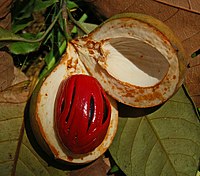
Photo from wikipedia
This experiment was conducted to define changes in metabolic pathways in response to mandibulate insect feeding and to provide a reference for further investigation of the molecular mechanisms underlying the… Click to show full abstract
This experiment was conducted to define changes in metabolic pathways in response to mandibulate insect feeding and to provide a reference for further investigation of the molecular mechanisms underlying the development of conifer resistance. Chinese pine (Pinus tabuliformis Carr.) in good growth status in natural condition was chosen for stimulation by 10 pine caterpillars (Dendrolimus tabulaefomis Tsai et Liu) as feeding stimulation (FS), leaf clipping control (LCC) as mechanical damage, and CK group (with no treatment) (recorded as 0 h). The metabolome and total flavonoid content were measured in the needles at 0, 2, and 8 h after treatment. Plant hormones were measured with needles at 0, 0.5, 1, 1.5, 2, 4, 6, and 8 h after different treatments. The results show that a total of 30.8% flavonoids are identified by metabolomics analysis. Compared with leaf clipping control, feeding stimulation of Chinese pine caterpillars significantly induced the upregulation of metabolites in the flavonoid pathway in Chinese pine, and the plant hormones JA and IAA showed expression trends consistent with those of the metabolome. According to the biological processes of the four plant hormones involved, JA and SA are mostly involved in resistance formation, and in this study, both of them also have fluctuating expressions influenced by feeding stimulation, while the expressions of the growth-related hormones IAA and ABA have no significant changes at other time points except for 1 h after treatment. Thus, the flavonoid pathway is one of the main pathways involved in resistance formation in conifers, and JA and IAA are involved in the formation of resistance.
Journal Title: Current Issues in Molecular Biology
Year Published: 2023
Link to full text (if available)
Share on Social Media: Sign Up to like & get
recommendations!